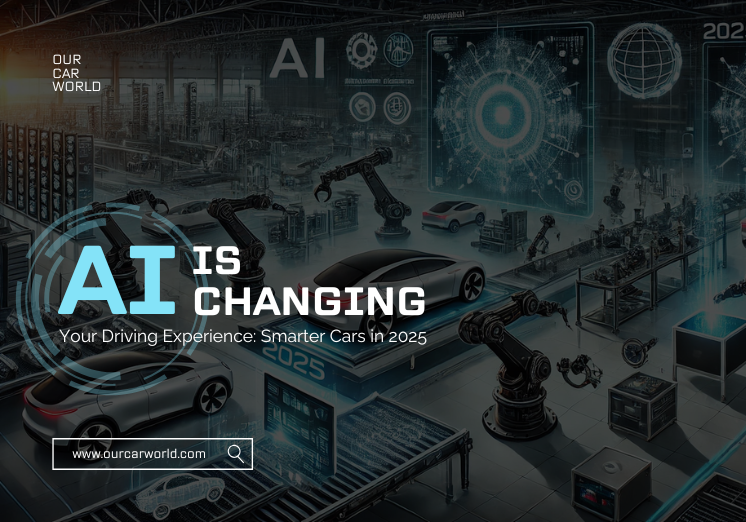Artificial Intelligence (AI) is no longer just a futuristic concept. In 2025, it is an integral part of the automotive world, redefining how we interact with vehicles. From improved safety systems to personalized driving experiences and advanced automation, AI is the core force behind the evolution of smart cars.
What is AI in Driving?
AI in driving refers to the use of machine learning, sensors, computer vision, and data analytics to enable cars to perform functions that were once exclusive to human drivers. This includes real-time decision-making, autonomous navigation, behavior prediction, and even communication with other vehicles and road infrastructure.
Key Areas Where AI is Revolutionizing Driving in 2025
Here are the major areas where AI in driving in 2025 is creating a transformative impact:
1. Enhanced Safety Systems
AI has significantly improved vehicle safety in 2025 through predictive and reactive systems:
- Adaptive cruise control and lane-keeping assist have evolved into more advanced autonomous assistance.
- AI-powered collision detection systems analyze surroundings faster than humans.
- Real-time monitoring of driver behavior helps prevent drowsiness and distraction-related accidents.
- Emergency braking systems are now smarter and more responsive.
2. Personalized Driving Experience
Cars are no longer just machines; they adapt to your preferences:
- AI tailors infotainment and climate settings based on previous trips and user behavior.
- Voice assistants understand natural language better than ever.
- Personalized seating positions, driving modes, and even music choices are saved and adjusted instantly.
3. Predictive Maintenance and Diagnostics
AI-enabled cars can now anticipate issues before they become problems:
- Real-time sensor data helps predict engine failures or tire issues.
- Notifications for oil changes, brake pad wear, or battery performance are delivered proactively.
- Workshop visits are smarter, with diagnostics already shared before you arrive.
4. Autonomous Driving & Traffic Navigation
While fully autonomous Level 5 vehicles are still being tested, AI in driving in 2025 supports advanced semi-autonomous features:
- Vehicles can autonomously park or change lanes safely.
- AI integrates with city traffic systems to offer real-time navigation and avoid congestion.
- Ride-sharing fleets increasingly use autonomous AI-driven vehicles.
5. Vehicle-to-Everything (V2X) Communication
Cars now communicate with each other and with traffic signals, road sensors, and even pedestrians:
- AI processes data from other vehicles to avoid accidents.
- Signal optimization allows vehicles to cruise without frequent stops.
- Emergency vehicles get right-of-way through AI-coordinated traffic systems.
How Car Owners Are Benefiting
The transformation isn’t limited to automakers. Car owners and drivers experience tangible improvements:
- Lower Accident Rates: AI reduces human error, a major cause of road accidents.
- Better Fuel Efficiency: Smart driving patterns and real-time suggestions lead to optimal fuel usage.
- Time Savings: Intelligent routing reduces commute time.
- Lower Maintenance Costs: Early diagnostics help avoid costly repairs.
AI’s Role in EVs and Sustainability
As electric vehicles (EVs) dominate the roads in 2025, AI complements their growth:
- AI balances energy usage in EVs to extend range.
- Charging stations equipped with AI direct drivers to the nearest available and fastest options.
- Sustainable driving behavior is encouraged through AI-based eco-feedback.
Artificial Intelligence is playing a significant role in transforming electric vehicles (EVs). From predictive battery health diagnostics to intelligent route optimization that factors in charging stations and traffic patterns, EVs in 2025 are smarter and more efficient than ever. These innovations are influencing many drivers to reconsider traditional fuel-based options.
If you’re exploring which option best fits your lifestyle and budget, check out our in-depth comparison: Electric Vehicles vs. Petrol Cars: Which One Wins in 2025?
Challenges Still Facing AI in Driving
Despite remarkable advances, some challenges remain:
- Data Privacy: Constant data collection raises concerns about user privacy.
- Cybersecurity: Connected vehicles are vulnerable to hacks if not properly secured.
- Regulations: Laws around autonomous driving and AI-based decisions are still catching up.
- Cost of Integration: High-end AI features are still expensive, limiting access to premium vehicles.
What to Expect Next in Smart Driving
In the coming years, expect more developments like:
- AI-powered insurance policies that adjust rates in real-time based on driving behavior.
- Emotion AI that detects stress or anger and adjusts the car environment accordingly.
- Fully autonomous vehicles for highways and urban commutes.
Final Thoughts
AI in driving in 2025 is not a distant dream but a reality enhancing everyday life for car owners. Whether it’s improving safety, cutting costs, or offering a tailored user experience, the technology is here to stay. As AI continues to learn and adapt, the future of driving promises to be smarter, safer, and more connected than ever before.

